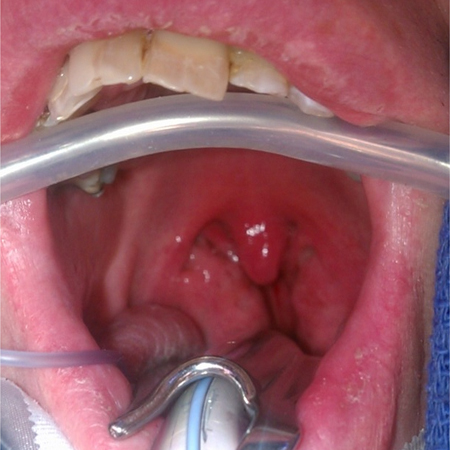The exact definition of dysphagia varies, but, in brief, dysphagia is difficulty with the act of swallowing solids or liquids. It may be subjective or objective and can refer to the sensation of not being able to swallow, food 'sticking' or not passing, choking episodes, or aspiration of food and/or liquids. It should be distinguished from odynophagia (pain on swallowing) and globus sensation (sensation of a lump in the throat between meals). Dysphagia can be caused by functional or structural abnormalities of the oral cavity, pharynx, oesophagus, or gastric cardia.[1]American College of Radiology. ACR appropriateness criteria: dysphagia. 2018 [internet publication].
https://acsearch.acr.org/docs/69471/Narrative
One in 17 people will develop dysphagia in their lifetime.[2]World Gastroenterology Organisation. WGO practice guideline - dysphagia. Sep 2014 [internet publication].
http://www.worldgastroenterology.org/guidelines/global-guidelines/dysphagia
The condition is reported to occur in 13% of the general population aged 65 years and older.[3]Turley R, Cohen S. Impact of voice and swallowing problems in the elderly. Otolaryngol Head Neck Surg. 2009 Jan;140(1):33-6.
http://www.ncbi.nlm.nih.gov/pubmed/19130958?tool=bestpractice.com
However, rates of 50% or more have been reported in older individuals in residential care.[4]Bloem B, Lagaay A, van Beek W, et al. Prevalence of subjective dysphagia in community residents aged over 87. Br Med J. 1990 Mar 17;300(6726):721-2.
http://www.ncbi.nlm.nih.gov/pmc/articles/PMC1662500/pdf/bmj00170-0035.pdf
http://www.ncbi.nlm.nih.gov/pubmed/2322725?tool=bestpractice.com
[5]Siebens H, Trupe E, Siebens A, et al. Correlates and consequences of eating dependency in institutionalized elderly. J Am Geriatr Soc. 1986 Mar;34(3):192-8.
http://www.ncbi.nlm.nih.gov/pubmed/3950287?tool=bestpractice.com
[6]Lin LC, Wu SC, Chen HS, et al. Prevalence of impaired swallowing in institutionalized older people in Taiwan. J Am Geriatr Soc. 2002 Jun;50(6):1118-23.
http://www.ncbi.nlm.nih.gov/pubmed/12110075?tool=bestpractice.com
Dysphagia affects 40% to 70% of people with stroke.[2]World Gastroenterology Organisation. WGO practice guideline - dysphagia. Sep 2014 [internet publication].
http://www.worldgastroenterology.org/guidelines/global-guidelines/dysphagia
Dysphagia is reported at initial presentation in up to 28% of patients with head and neck cancer, and in up to 50% of patients with pharyngeal cancers.[7]Kuhn MA, Gillespie MB, Ishman SL, et al. Expert consensus statement: management of dysphagia in head and neck cancer patients. Otolaryngol Head Neck Surg. 2023 Apr;168(4):571-92.
https://aao-hnsfjournals.onlinelibrary.wiley.com/doi/10.1002/ohn.302
http://www.ncbi.nlm.nih.gov/pubmed/36965195?tool=bestpractice.com
[8]Dysphagia Section, Oral Care Study Group, Multinational Association of Supportive Care in Cancer (MASCC)/International Society of Oral Oncology (ISOO); Raber-Durlacher JE, Brennan MT, et al. Swallowing dysfunction in cancer patients. Support Care Cancer. 2012 Mar;20(3):433-43.
https://www.ncbi.nlm.nih.gov/pmc/articles/PMC3271214
http://www.ncbi.nlm.nih.gov/pubmed/22205548?tool=bestpractice.com
It is also an acute and chronic adverse effect of treatment for head and neck cancer.[7]Kuhn MA, Gillespie MB, Ishman SL, et al. Expert consensus statement: management of dysphagia in head and neck cancer patients. Otolaryngol Head Neck Surg. 2023 Apr;168(4):571-92.
https://aao-hnsfjournals.onlinelibrary.wiley.com/doi/10.1002/ohn.302
http://www.ncbi.nlm.nih.gov/pubmed/36965195?tool=bestpractice.com
Dysphagia may be treated by various specialties or ideally by a multi-specialty team. The core of such a team includes the patient’s primary care physician, otolaryngologists, speech and swallowing therapists, gastroenterologists, and radiologists. In addition, neurologists, dieticians, oncologists, general surgeons, and thoracic surgeons are often involved in the patient’s care.
Swallowing, and therefore difficulty swallowing, can be anatomically and physiologically divided easily into three distinct parts: the oral phase, the pharyngeal phase, and the oesophageal phase.
The oral phase (sometimes referred to as the preparatory phase) is the voluntary phase that occurs in the oral cavity. Mastication with salivary lubrication and tongue movement prepares the bolus to be thrust posteriorly into the pharynx.
The pharyngeal phase involuntarily transfers the bolus of food and/or liquid from the mouth to the oesophagus. Its coordinated contractions not only are necessary to propel the bolus but are crucial in protecting the larynx and upper airway from aspiration of material into the airway and lung.
The oesophageal phase is the involuntary phase that utilises peristalsis to propagate the food/liquid bolus through the oesophagus into the stomach. The oesophagus is bound by upper and lower sphincters (the upper formed by the cricopharyngeus muscle), which prevent retrograde flow of stomach contents into the oesophagus.
